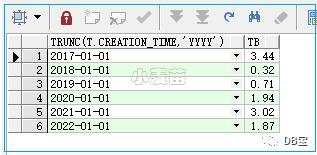Oracle使用SQL语句查询表空间或数据库的增长量
Oracle使用SQL语句查询表空间或数据库的增长量

AiDBA宝典
发布于 2023-04-27 13:31:21
发布于 2023-04-27 13:31:21
代码可运行
运行总次数:0
代码可运行
简介
在Oracle数据库中,我们有时候在分析一些问题时,需要了解哪一些表空间的数据增长了。我们需要快速定位数据量增长较快的用户表空间,或者在哪一些时间段表空间数据量突然飚增了。
10g或11g
SELECT a.snap_id,
c.tablespace_name ts_name,
to_char(to_date(a.rtime, 'mm/dd/yyyy hh24:mi:ss'), 'yyyy-mm-dd hh24:mi') rtime,
round(a.tablespace_size * c.block_size / 1024 / 1024, 2) ts_size_mb,
round(a.tablespace_usedsize * c.block_size / 1024 / 1024, 2) ts_used_mb,
round((a.tablespace_size - a.tablespace_usedsize) * c.block_size / 1024 / 1024,
2) ts_free_mb,
round(a.tablespace_usedsize / a.tablespace_size * 100, 2) pct_used
FROM dba_hist_tbspc_space_usage a,
(SELECT tablespace_id,
substr(rtime, 1, 10) rtime,
max(snap_id) snap_id
FROM dba_hist_tbspc_space_usage nb
group by tablespace_id, substr(rtime, 1, 10)) b,
dba_tablespaces c,
v$tablespace d
where a.snap_id = b.snap_id
and a.tablespace_id = b.tablespace_id
and a.tablespace_id=d.TS#
and d.NAME=c.tablespace_name
and to_date(a.rtime, 'mm/dd/yyyy hh24:mi:ss') >=sysdate-30
order by a.tablespace_id,to_date(a.rtime, 'mm/dd/yyyy hh24:mi:ss') desc;
或:
set linesize 860;
set pagesize 120;
alter session set nls_date_format='yyyy-mm-dd hh24:mi:ss';
col tb_name for a16;
col ts_mb for 999,999,999.90
col max_mb for 999,999,999.90
col used_mb for 999,999,999.90
col last_mb for 999,999,999.90
col incr for 999,999.90
select * from (
select v.name tb_name
,v.ts#
,s.instance_number
,h.tablespace_size
* round(p.value/1024/1024,2) ts_mb
,h.tablespace_maxsize
* round(p.value/1024/1024,2) max_mb
,h.tablespace_usedsize
* round(p.value/1024/1024,2) used_mb
,to_date(h.rtime, 'MM/DD/YYYY HH24:MI:SS') resize_time
,lag(h.tablespace_usedsize * p.value/1024/1024, 1, h.tablespace_usedsize * p.value/1024/1024) over (partition by v.ts# order by h.snap_id) last_mb
,(h.tablespace_usedsize * p.value/1024/1024) - lag(h.tablespace_usedsize * p.value/1024/1024, 1, h.tablespace_usedsize * p.value/1024/1024) over (partition by v.ts# order by h.snap_id) incr
from dba_hist_tbspc_space_usage h
, dba_hist_snapshot s
, v$tablespace v
, dba_tablespaces t
, v$parameter p
where h.tablespace_id = v.ts#
and v.name = t.tablespace_name
and t.contents not in ('UNDO', 'TEMPORARY')
and p.name = 'db_block_size'
and h.snap_id = s.snap_id
/* For a specific time */
and s.begin_interval_time > sysdate - 7
-- and v.name =upper('&tablespace_name')
order by v.name, h.snap_id asc)
where incr > 0;
12c或更高版本
SELECT a.snap_id,
a.con_id,
e.name pdbname,
c.tablespace_name ts_name,
to_char(to_date(a.rtime, 'mm/dd/yyyy hh24:mi:ss'), 'yyyy-mm-dd hh24:mi') rtime,
round(a.tablespace_size * c.block_size / 1024 / 1024, 2) ts_size_mb,
round(a.tablespace_usedsize * c.block_size / 1024 / 1024, 2) ts_used_mb,
round((a.tablespace_size - a.tablespace_usedsize) * c.block_size / 1024 / 1024,
2) ts_free_mb,
round(a.tablespace_usedsize / a.tablespace_size * 100, 2) pct_used
FROM cdb_hist_tbspc_space_usage a,
(SELECT tablespace_id,
nb.con_id,
substr(rtime, 1, 10) rtime,
max(snap_id) snap_id
FROM dba_hist_tbspc_space_usage nb
group by tablespace_id, nb.con_id,substr(rtime, 1, 10)) b,
cdb_tablespaces c,
v$tablespace d,
V$CONTAINERS e
where a.snap_id = b.snap_id
and a.tablespace_id = b.tablespace_id
and a.con_id=b.con_id
and a.con_id=c.con_id
and a.con_id=d.con_id
and a.con_id=e.con_id
and a.tablespace_id=d.TS#
and d.NAME=c.tablespace_name
and to_date(a.rtime, 'mm/dd/yyyy hh24:mi:ss') >=sysdate-30
order by a.CON_ID,a.tablespace_id,to_date(a.rtime, 'mm/dd/yyyy hh24:mi:ss') desc;
或:
-- 注意:此脚本要在CDB下执行才能查看所有PDB的表空间信息。如果在指定的PDB下执行的,只能查看当前PDB的表空间增长信息
set linesize 860;
set pagesize 120;
alter session set nls_date_format='yyyy-mm-dd hh24:mi:ss';
col con_id for 999
col name for a16
col ts# for 999
col ts_mb for 999,999,999.90
col max_mb for 999,999,999.90
col used_mb for 999,999,999.90
col last_mb for 999,999,999.90
col incr for 999,999.90
select * from (
select v.con_id
,v.name
,v.ts#
,s.instance_number
,h.tablespace_size
* p.value/1024/1024 ts_mb
,h.tablespace_maxsize
* p.value/1024/1024 max_mb
,h.tablespace_usedsize
* p.value/1024/1024 used_mb
,to_date(h.rtime, 'MM/DD/YYYY HH24:MI:SS') resize_time
,lag(h.tablespace_usedsize * p.value/1024/1024, 1, h.tablespace_usedsize * p.value/1024/1024) over (partition by v.ts# order by h.snap_id) last_mb
,(h.tablespace_usedsize * p.value/1024/1024) - lag(h.tablespace_usedsize * p.value/1024/1024, 1, h.tablespace_usedsize * p.value/1024/1024) over (partition by v.con_id, v.ts# order by h.snap_id) incr
from cdb_hist_tbspc_space_usage h
, cdb_hist_snapshot s
, v$tablespace v
, cdb_tablespaces t
, v$parameter p
where h.tablespace_id = v.ts#
and h.con_id = v.con_id
and h.con_id = t.con_id
and v.name = t.tablespace_name
and v.con_id = t.con_id
and t.contents not in ('UNDO', 'TEMPORARY')
and p.name = 'db_block_size'
and h.snap_id = s.snap_id
/* For a specific time */
and s.begin_interval_time > sysdate - 7
-- and v.name =upper('&tablespace_name')
order by v.con_id, v.name, h.snap_id asc)
where incr > 0;
如何估算oracle数据库对象历史增长情况
最近七天数据库的增长情况,这个只是一个估算值。
select sum(space_used_total)/1024/1024/1024 "last 7 days db increase - G"
from dba_hist_seg_stat s,
dba_hist_seg_stat_obj o,
dba_hist_snapshot sn
where s.obj# = o.obj#
and sn.snap_id = s.snap_id
and begin_interval_time > sysdate-8
order by begin_interval_time;
其它SQL
SYSTEM表空间增量量
select u.snap_id,
to_char(s.begin_interval_time, 'yyyy-mm-dd hh24') begin_time,
to_char(s.end_interval_time, 'yyyy-mm-dd hh24') end_time,
t.name,
round(u.tablespace_size * ts.block_size / 1024 / 1024, 2) ts_size_mb,
round(u.tablespace_usedsize * ts.block_size / 1024 / 1024, 2) ts_used_mb,
round((u.tablespace_size - u.tablespace_usedsize) * ts.block_size / 1024 / 1024, 2) ts_free_mb,
round(u.tablespace_usedsize / u.tablespace_size * 100, 2) pct_used
from dba_hist_tbspc_space_usage u,
v$tablespace t,
dba_hist_snapshot s,
dba_tablespaces ts
where u.tablespace_id = t.ts#
and u.snap_id = s.snap_id
and t.name = ts.tablespace_name
and s.instance_number = 1
and t.name = 'SYSTEM'
and s.end_interval_time > sysdate - 7
order by snap_id desc;
不含undo和temp
with tmp as
(select rtime,
sum(tablespace_usedsize_kb) tablespace_usedsize_kb,
sum(tablespace_size_kb) tablespace_size_kb
from (select rtime,
e.tablespace_id,
(e.tablespace_usedsize) * (f.block_size) / 1024 tablespace_usedsize_kb,
(e.tablespace_size) * (f.block_size) / 1024 tablespace_size_kb
from dba_hist_tbspc_space_usage e,
dba_tablespaces f,
v$tablespace g
where e.tablespace_id = g.TS#
and f.tablespace_name = g.NAME
and f.contents not in ('TEMPORARY','UNDO'))
group by rtime)
select tmp.rtime,
tablespace_usedsize_kb,
tablespace_size_kb,
(tablespace_usedsize_kb -
LAG(tablespace_usedsize_kb, 1, NULL) OVER(ORDER BY tmp.rtime)) AS DIFF_KB
from tmp,
(select max(rtime) rtime
from tmp
group by substr(rtime, 1, 10)) t2
where t2.rtime = tmp.rtime;
含undo和temp
with tmp as
(select min(rtime) rtime,
sum(tablespace_usedsize_kb) tablespace_usedsize_kb,
sum(tablespace_size_kb) tablespace_size_kb
from (select rtime,
e.tablespace_id,
(e.tablespace_usedsize) * (f.block_size) / 1024 tablespace_usedsize_kb,
(e.tablespace_size) * (f.block_size) / 1024 tablespace_size_kb
from dba_hist_tbspc_space_usage e,
dba_tablespaces f,
v$tablespace g
where e.tablespace_id = g.TS#
and f.tablespace_name = g.NAME)
group by rtime)
select tmp.rtime,
tablespace_usedsize_kb,
tablespace_size_kb,
(tablespace_usedsize_kb -
LAG(tablespace_usedsize_kb, 1, NULL) OVER(ORDER BY tmp.rtime)) AS DIFF_KB
from tmp,
(select min(rtime) rtime
from tmp
group by substr(rtime, 1, 10)) t2 where t2.rtime = tmp.rtime;
列出相关段对象在 快照时间内的使用空间的历史变化信息
column owner format a16
column object_name format a36
column start_day format a11
column block_increase format 9999999999
select obj.owner, obj.object_name,
to_char(sn.BEGIN_INTERVAL_TIME,'RRRR-MON-DD') start_day,
sum(a.db_block_changes_delta) block_increase
from dba_hist_seg_stat a,
dba_hist_snapshot sn,
dba_objects obj
where sn.snap_id = a.snap_id
and obj.object_id = a.obj#
and obj.owner not in ('SYS','SYSTEM')
and end_interval_time between to_timestamp('17-FEB-2014','DD-MON-RRRR')
and to_timestamp('25-FEB-2014','DD-MON-RRRR')
group by obj.owner, obj.object_name,
to_char(sn.BEGIN_INTERVAL_TIME,'RRRR-MON-DD')
order by obj.owner, obj.object_name ;
统计 Oracle 数据库每年数据增长量
统计数据库的规模一般会从两个维度考虑,一个是真实的数据库对象所占的空间,另一个是物理磁盘需要占多少空间。
前者是逻辑对象的数据规模,后者是磁盘上实际的数据文件大小。逻辑对象是存在物理文件中的,文件提前分好了空间,文件内容会等待逻辑对象填满。比如提前分好了一个32GB的表空间,数据没存满前,文件大小不会变,但对象所占的空间是在增长的。
统计数据库数据量大小的 SQL 语句如下:
-- 对象大小
select sum(t.bytes)/1024/1024/1024/1024 TB from dba_segments t;
-- 数据文件大小
select sum(t.bytes)/1024/1024/1024/1024 TB from dba_data_files t;
如果需要统计每年的数据库的数据量的增长量,一种笨办法则是每年统计一次,将结果存下来,多年之后再将数据取出来进行分析。Oracle中并不会记录数据增长的历史,唯一一种可以近似得到数据增长历史的地方是v

datafile统计的数据增长量如下:

图片
SQL语句为:
SELECT trunc(t.creation_time, 'yyyy'),
round(SUM(t.bytes) / 1024 / 1024 / 1024 / 1024, 2) tb
FROM v$datafile t
GROUP BY trunc(t.creation_time, 'yyyy')
ORDER BY 1;
这里有一个问题就是如果数据库的生命周期不完整了,比如经历过数据迁移、resetlog 导致归档日志不再连接,此时 v$datafile 中记录的数据文件创建时间已经被重置,之前的历史记录会丢失。此时数据库相当于重生了,之前的数据文件创建时间都被重置为数据库的第一次打开时间。比如上面的记录 2017 年以前的数据文件增长记录都无法考证了,原因是经历过 resetlog 打开数据库。

图片
参考
https://www.modb.pro/db/521210
https://mp.weixin.qq.com/s/igESMLiAbJjeAtuN3FWmhw
本文参与 腾讯云自媒体同步曝光计划,分享自微信公众号。
原始发表:2023-02-16,如有侵权请联系 cloudcommunity@tencent.com 删除
评论
登录后参与评论
推荐阅读
目录

